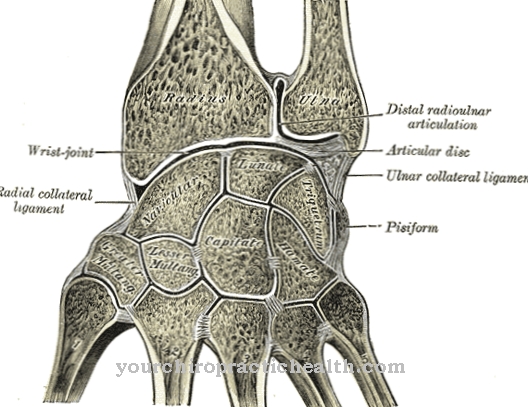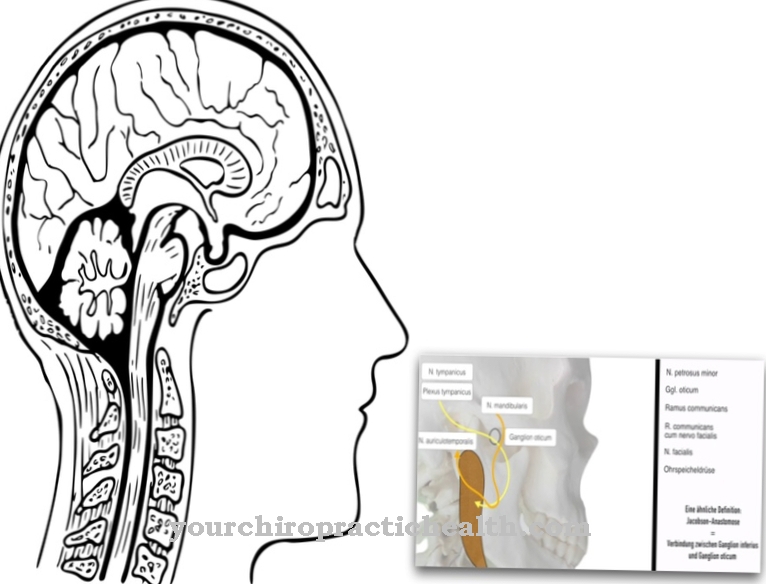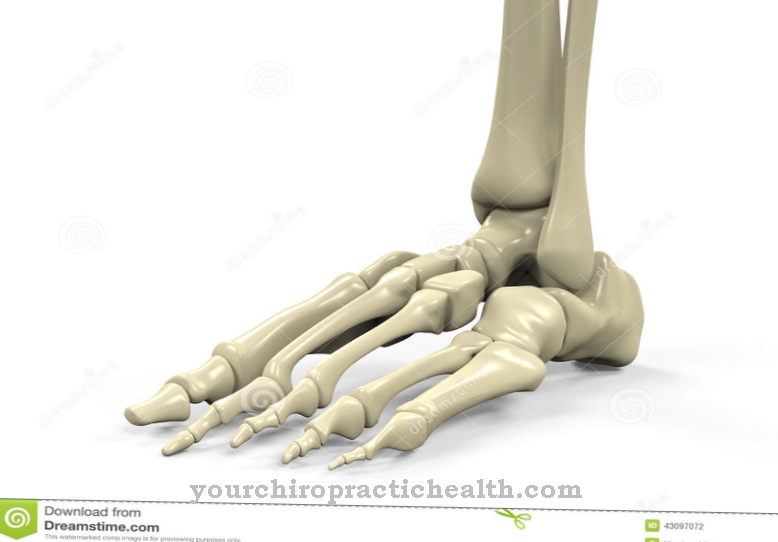Of the auditory nerve is one of the most important nerves, as it is responsible for transmitting acoustic information to the brain.
If its function is disturbed - this can happen, for example, due to infections of the inner ear, loud noise or circulatory disorders - the hearing ability of the person concerned is reduced. In the most severe cases it can even lead to numbness. Impairments to the transmission of sound or misinterpretations of the signals should be taken seriously, otherwise the patient will experience a severe impairment of his quality of life.
What is the auditory nerve?
As an auditory nerve (Vestibucochlear nerve) is the eighth of a total of 12 cranial nerves that lead from the balance organ of the inner ear to the brain. Unlike other nerves, it is not a single nerve strand, but a twin nerve. It consists of the cochlear nerve - formerly called the acoustic nerve - and the vestibular nerve (older name: static nerve).
The cochlear nerve is the actual auditory nerve, while the vestibular nerve is the equilibrium nerve. Both nerve cords run parallel until they unite in the brain stem to form the vestibucochlear nerve. The auditory nerve and the equilibrium nerve are located outside the inner ear.
Anatomy & structure
The cochlea in the inner ear and the organ of equilibrium are filled with lymphatic fluid containing tiny hair cells. The auditory nerve starts at the center of the coils of the cochlea and ends in the two auditory nuclei, the ventral cochlear nerve and the dorsal cochlear nerve, in the myelencephalon.
From these auditory nuclei, nerve pathways lead to the auditory cortex (Heschl's transverse turns) in the cerebrum. The equilibrium nerve runs at the bottom of the inner bony ear canal. Six of its nerve cords are connected to the receptors of the balance organ in the inner ear.
Function & tasks
The hair cells of the cochlea are stimulated by movements of the lymph - triggered by the pressure oscillations of the incoming sound waves - to emit nerve impulses, which the auditory nerve picks up and, after exiting the cochlea, forwards them to the brain in the form of bio-electrical signals via afferent pathways, where they are analyzed and evaluated in the auditory cortex (cerebral cortex).
After stimulus processing, the acoustic signals are sent from there via efferent pathways to the inner ear, which then fine-tunes the sense of hearing. The hair cells in the organ of equilibrium recognize changes in movement and direction and also send out impulses. They are then sent to the brain (brain stem) via the equilibrium nerve on afferent pathways for information processing and evaluation. From there they go to the cerebellum. There, as a result of a comparison of the incoming information with other sensory impressions from the muscle and eye sensors, the position perception of the body is created. It is necessary so that humans can make coordinated movements.
You can find your medication here
➔ Medicines for earache and inflammationDiseases
If the transmission of acoustic stimuli is disturbed or even temporarily or permanently damaged, diseases of the auditory nerve occur. Its function can be impaired by the acoustic neuroma, tinnitus, sudden hearing loss, hearing loss, deafness, inflammation and other diseases.
The acoustic neuroma is a slowly growing benign tumor, which - if its spread is not stopped - can be life-threatening for the patient. It usually only forms on one side of the equilibrium nerve or proliferates between the auditory and equilibrium nerves. It is still unclear what factors are involved in its development. The acoustic neuroma presses on the auditory nerve as it grows and therefore disrupts the transmission of information to the cerebral cortex. The bio-electrical signals no longer arrive in their correct form because of the growth: The patient hears that something has been said, but does not understand what was said. The main symptoms of the disease are unilateral hearing loss and hearing noises (tinnitus).
At a later stage of the disease, the facial nerve can also be affected. If the tumor is so large that it causes serious health problems, the patient must be operated on in a specialist ENT clinic. A sudden hearing loss is understood to be sudden deafness or hearing impairment that usually occurs on one side. At first, the person affected has the feeling of hearing everything as if through cotton wool, then tinnitus usually occurs. Due to the damage to the hair cells, the sound vibrations arriving in the ear can no longer be properly absorbed. The exact causes of the disease are not known.
Doctors assume that they are triggered by circulatory disorders in the inner ear. It can also cause diabetes mellitus, strokes and infections. Damage to the auditory nerve can also lead to inner ear hearing loss and deafness. The sound is no longer properly transmitted through the eardrum and ossicles. The cause is usually a pathological change in the auditory nerve due to infection or injury. Tinnitus refers to hearing certain tones and noises that have no external sound source. The patient hears a ringing, buzzing sound, etc. Tinnitus patients usually have a sudden hearing loss before symptoms first appear. In mild cases, the affected person's perception and performance are not impaired.
Chronic tinnitus with frequent misperceptions can even lead to inability to work. Causes of tinnitus are degenerative diseases of the inner ear, an occlusion of the ear canal or stress. Other diseases that damage the auditory nerve are herpes zoster oticus. Herpes viruses not treated with antivirals attack the tissue of the auditory nerve. Meningitis pathogens can also infect it. Auditory neuropathy occurs when the hair cells are not properly connected to the auditory nerve. An impaired auditory nerve also occurs in multiple sclerosis.
Typical & common ear diseases
- Ear flow (otorrhea)
- Otitis media
- Ear canal inflammation
- Mastoiditis
- Ear furuncle

























.jpg)

.jpg)
